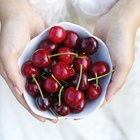
To get the most benefits out of eating fruits and vegetable, you should eat at least one daily serving from each of the five color groups--blue/purple, green, white, yellow/orange and red--as the "Color Way" campaign by the Produce for Better Health Foundation suggests. This campaign is also known as "The Five Color Diet" or the "5 A Day" diet.
History
In 1988, the National Cancer Institute provided a grant to the California Department of Health to start a pilot project--"5 A Day for Better Health"--to promote fruit and vegetable consumption. The program rapidly gained national support and, in 1991, the Produce for Better Health Foundation, or PBH, was formed as a co-sponsor of the program. Over the decade, the foundation has delivered the "5 A Day" message to the public through media, supermarkets and growers to promote health and nutrition awareness. In 2001, the program expanded to include other health institutes and governing agencies such as the Centers for Disease Control and Prevention, and several parts of the U.S. Department of Agriculture, or USDA. The PBH introduced the "Color Way" campaign in 2002 to stress the importance of variety in fruit and vegetable consumption.
Significance
According to the PBH, more than 50 percent of Americans today are overweight or obese, with a rising number of children being overweight. Overweight and obesity can lead to heart disease, cancers, type-2 diabetes, stroke, arthritis, cardiovascular disease and psychological disorders. Choosing healthier foods can help reduce these risks.
Features
The "5 A Day-The Color Way" campaign focuses not only on eating 5 servings of fruits and vegetables a day, but also from 5 different colors. Blues/purples include blueberries, blackberries, purple grapes, prunes, raisins and eggplants. They contain flavonoids, phytochemicals and antioxidants such as anthocyanins, vitamin C, folic acid and polyphenols. White vegetables include garlic, chives, onion, cauliflowers and potatoes. White fruits are bananas and pears. Reds such as tomatoes, watermelon, grapefruit, raspberries, red apples and kidney and red beans contain antioxidants lycopene and anthocyanins. Greens are rich in phytochemicals and essential vitamins, minerals and fiber. They include spinach, leafy greens, kiwifruit and honeydew melon. Yellow and orange vegetables and fruits include carrots, sweet potatoes, pumpkin, cantaloupe, peaches, oranges, papaya and pineapple. They contain beta-carotene, vitamin C, vitamin E, folate and bioflavonoids.
Benefits
Frequent fruit and vegetable consumption can help your body defend against cancer, control high blood pressure, maintain memory, promote healthy aging, healthy weight and strong bones and teeth, and reduce risk of type-2 diabetes, cardiovascular diseases and pulmonary diseases.
Potential
According to the Center for Communications, Health and the Environment, the "Color Way" and "5 A Day" campaign may have played a part in the slight increase in vegetable and fruit intake recorded between 1991 and 1997 by the USDA.
Related Articles

Different Types of Fruits & Vegetables

Summer Programs for Kids in Greeley, CO

What Is the Meaning of Colored Bandanas?

What Do the Colors of Mardi Gras Beads ...

Nutritional Values of Vegetables ...

Traditional Korean Colors

Youth Mentoring Discussion Topics

Can Age Spots Be Reversed?

Should I Wash My Hair Before Using Hair ...

What Does Kigelia Fruit Extract Do for ...

Can LED Light Get Rid of Brown Spots on ...

What Are the Colors for Wedding ...

Children's Clothes in 1910

African American Holidays & Traditions

What Is Ceylon Sapphire?

What Is the Meaning of Flag Day in the ...

What Are Piaget's 6 Stages of Child ...

How to Prepare a Mother's Day Service

How to Shrink Cotton Shirts

Names of Different Red Shades
References
Writer Bio
Pik Ho has been writing nutrition-related articles for a weight-loss center, where she worked as a Nutrition Consultant, since 2008. Ho was ServSafe Certified in 2007. She holds a Bachelor of Science in Dietetics from San Francisco State University.
Photo Credits
fruit and vegetables image by photo25th from Fotolia.com